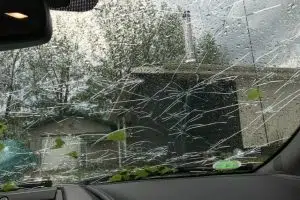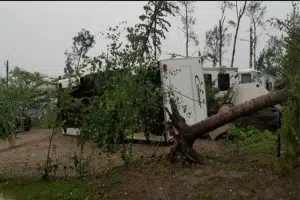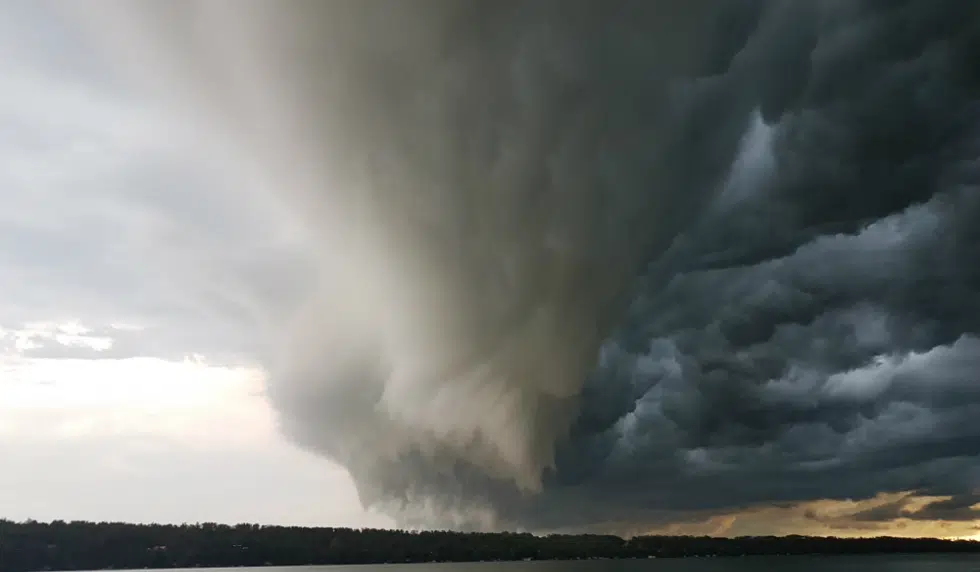‘When the thunder roars, stay indoors.’
That’s the mantra that Environment Canada follows when it comes to storm season on the prairies, as curious Saskatchewanians creep out of their homes to catch a glimpse of the short, yet ever-intriguing storm season the province boasts.
According to its meteorologist Terri Lang, storm season on the prairies has officially arrived, and that’s welcome news for those who like to keep their eyes on the Saskatchewan sky.
“We do have a big community of weather enthusiasts. We also have a big storm chaser community. If you really like seeing pictures of storms, (social media) on #SKStorm (is) a great place to see,” she told 650 CKOM Monday.
#SKStorm on Twitter is a resource that Environment Canada does use to track reports of storms within the prairies, according to Lang.

Bruce Dorward’s windshield after the hail storm at Mistusinne Resort Village. (submitted/Bruce Dorward)
“That’s a great place to post pictures or video, or reports that you have about the weather. Saskatchewan’s a really big province with a lot of empty space in-between places, so we can’t see everything,” she said.
That “empty space” translates to a lot of coverage that potentially goes missed over the storm season. But along with social media, Environment Canada also asks storm watchers to send in their reports to skstorm@canada.ca, or by calling 1 (800) 239-0484. That allows it to fill the gap, and see what is happening throughout the province.
When reporting though, Lang explained that there is one thing you can do to give meteorologists an accurate representation of hailstones when storms produce that kind of precipitation. If you’re sending in photos, make sure to add in a reference.
That could be a ping pong ball, a golf ball or tennis balls. If you’re looking to show them hail compared to a coin, make sure that coin is tails up so they can dictate whether its a dime, or a quarter.
If that hail is in your hand, Lang explained the reference can be the missing link to show just how severe the weather did ultimately get.
“Is that a child’s hand? Is that a giant hand? It’s always good to have some kind of reference,” she said.
When it comes to Saskatchewan weather, things are pretty unpredictable. From wind to rain, hail, tornados and plough winds, anything can happen at any time.
Lang says Saskatchewanians can always follow along with the latest look at the radar on Environment Canada’s website, or on the WeatherCan app on your smartphone.
SaskAlerts also can give you push notifications that can be helpful, especially if you’re travelling. Both applications track where you are geographically, allowing you to have the most up to date information always on hand.
Environment Canada classifies storms, and what you should watch out for, in two different ways, something that Lang says many need to be reminded of yearly.
Weather watch versus weather warning
“A ‘watch’ means all the ingredients are there for severe weather. Kinda just be on the lookout,” she said.
“When (ingredients) come together and severe weather is imminent, that’s when a warning is issued… that’s when it’s time to take immediate action.”
Lang says storm season was a bit later this year, as the spring was cooler than past years.
“We know that the prime season for that really severe weather – the big thunderstorms, the big hail, the chances of tornadoes, really big rains. Usually all of June and about the first half of July, that’s the main season for the really, really big storms,” she explained.
Heat and daylight are also factors from the end of July to the month of August, when the storm season starts to taper off.

Campers were flipped over and trees were uprooted after a storm tore through Meadow Lake Provincial Park on June 29, 2019. (Barry Butler/Submitted)
But, just because the storm season is over, doesn’t mean storms disappear on the prairies.
“It doesn’t mean it can’t happen. We just see less of them,” Lang said.
In terms of safety, Lang says there are many that need to be aware of just how dangerous these storms may become.
“I know most Saskatchewan residents love thunderstorms. They like watching them, they like sitting out, the whole bit,” she said.
“(However), every year, we have people injured because they go under a tree during a lightning storm. Growing up in Saskatchewan, I don’t understand how that happens because we’ve been told right from the get-go as young children: Don’t go under a tree during a thunderstorm. There’s a reason for that.”
Tornadoes are also not uncommon for Saskatchewan, but plough winds have become more common over the years.
Lang says they’ve tracked dangerous plough winds, some as strong as an EF2 tornado.
In that case, she has some things to stay mindful of if you do find yourself in a situation of that nature.
“When the winds really do come up (during a tornado or a plough wind) we always tell people to get to the basement, (or) to the most interior room that they have,” she said.
“If you can put as many walls between yourself and the outside as you can, that’s what you should do.”











